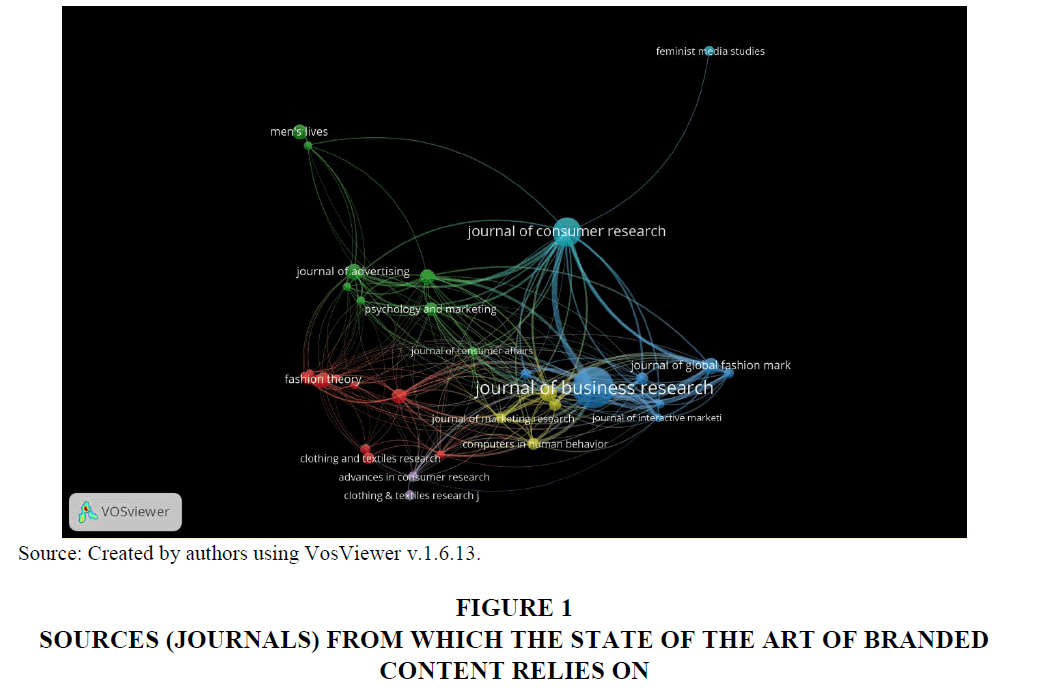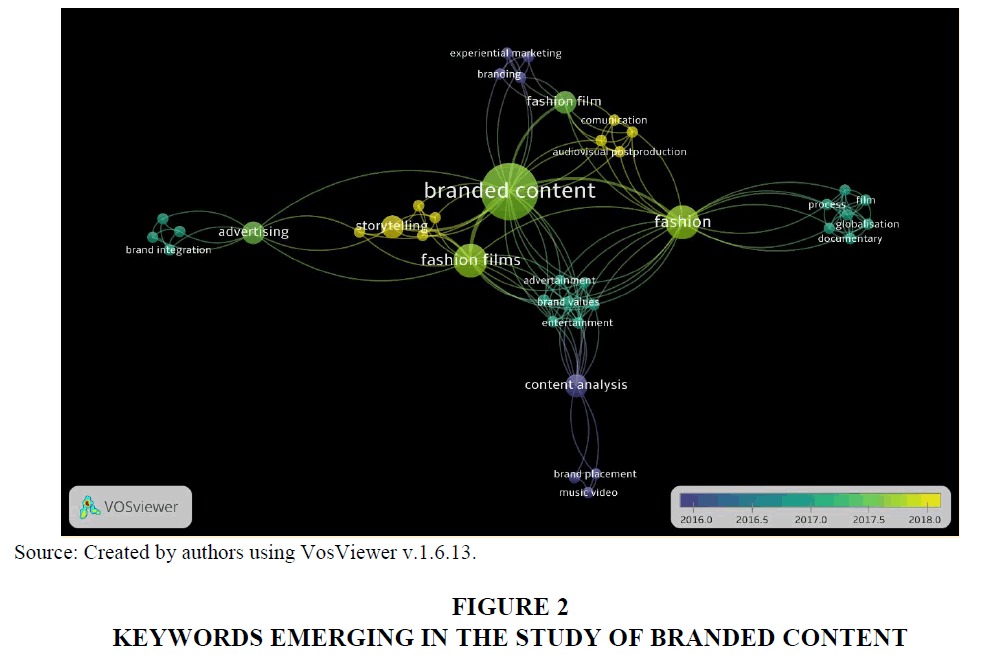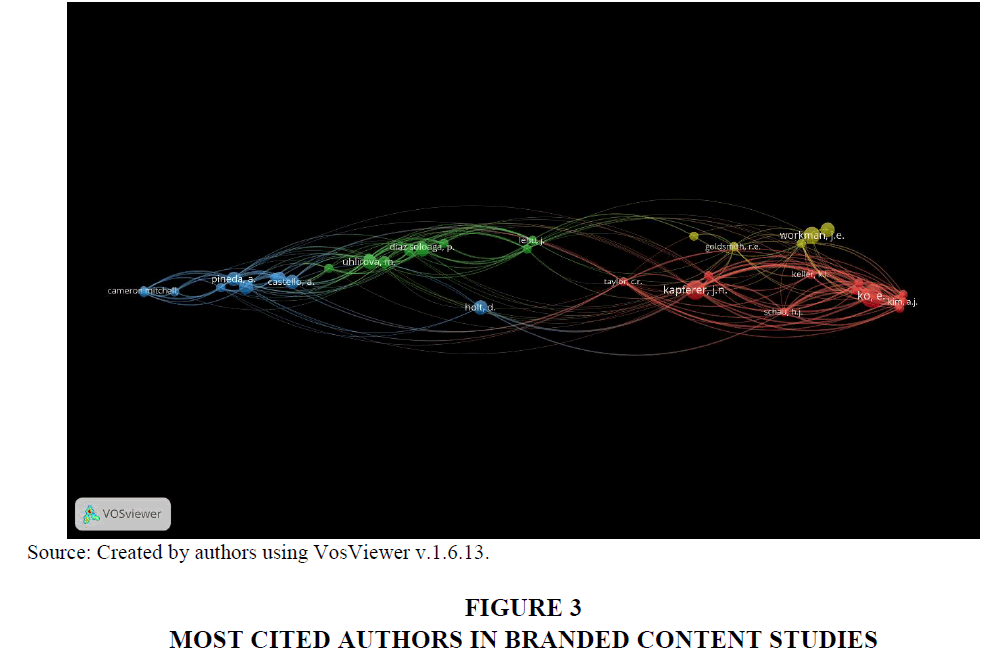Research Article: 2020 Vol: 24 Issue: 1
Branded Content in Fashion Research: Bibliometric Analysis by Correlations
Bárbara Castillo-Abdul, University of Huelva/ESAI Business School, Espiritu Santo University
Luis M. Romero-Rodríguez, Rey Juan Carlos University/ Universidad Nebrija
Amor Pérez-Rodríguez, University of Huelva
Abstract
Information and Communication Technologies (ICT) have revolutionized all human interactions, creating new spaces and platforms for consumption and entertainment. In that regard, marketing and advertising have had to adapt by refocusing existing tools, as well as creating new strategies to reach their target audiences. Among these emerging tools are the Branded Content, which combines the conventional advertising message with entertainment and ICT, to create emotional and entertainment links between the consumer and the brands. However, given the novelty of Branded Content as an object of academic study, this research seeks to make a mapping of the state of the art that serves as a starting point for the epistemological understanding of the phenomenon, as well as to know the different conceptual positions of the most cited authors of Branded Content, specifically in fashion marketing research. For this objective, a bibliometric analysis is performed through a strategy of co-occurrence and co-citation of Boolean operators from the Scopus database, using the BibExcel tool for frequency counting and VosViewer for the visualization of data and interaction maps. The results indicate that between 2016 and 2018 the co-citation keywords varied widely, from terms such as "content analysis" and "marketing" in 2016, to "fashion films" in 2018, which clearly shows that there is not yet an academic and possibly even a pragmatic consensus on the delimitations of Branded Content.
Keywords
Marketing, Branding, Fashion Marketing, Media, Fashion Film, Advertising.
Introduction
The term “Branded Content” is increasingly used among advertisers and brand managers to refer to a promotion and positioning strategy (Lou et al., 2019). The use of the term is increasingly common, so much so that it has made inroads into television programming (ABC, 2013). Branded Content emerges to transform advertising, incorporating media, tools, and processes with the support of Information and Communication Technologies (ICT) (Ashley & Tuten, 2013). Although this is not a new development, it has been adjusted to the needs and realities of the present day, placing, above all, the relevance and reputation of the brand in order to maintain its position (Lipsman et al., 2012; Ros, 2013).
Of course, the term has been evolving, so it is common to find epistemological oppositions between the approaches of different authors, being part of the academic interest to limit its axiology (Hudson & Hudson, 2006; Regueira, 2012). In this sense, the Branded Content is the creation of added values to the brand, through the commercial message, which can be called in different ways, such as:
“Branded Entertainment, Advertainment, Consumer Engagement, Branded Cultural Movements or Branded Creative Content” (García, 2007).
Branded Content, in summary, is a commercial-advertising strategy that seeks to attract the attention of external stakeholders - clients and potential clients -, so it can be said that it tries to transform "brand content" into an attractive asset for the target, allowing them, through the commercial message, to be entertained, informed, free from routine, and feel satisfied; thus implying a new way of establishing the communicational process (Keller, 2009). In this sense, Díaz-Soloaga & Muñiz-Muriel (2011) propose that although communication is how the public is reached, the brand must establish the channels to transmit its message strategically. Therefore, all commercial communication must consider its target audience and make use of technologies to generate entertaining and interesting content that is adapted to what the customer wants to see and, in this way, appropriate the brand, create a sense of belonging to it, and acquire the product.
Within the conceptualizations, Regueira (2012) proposes an approach in which the brand is inserted through entertainment, so the communication campaign seeks to create, design, and distribute a specific message about it, according to what consumers need and want. On the other hand, Carreras (2014) considers that the Branded Content implies a communication out of the conventional, in which the intention is to favor the experience of the brand, while the public is entertained or is in its moment of leisure because the users are the ones who look for and access the information of the product or service. While, Casas-Alatriste et al. (2013) and Badenhausen (2015) consider that the Branded Content is the content that the public receives, allowing an approach to the brand, in a fun, innovative way, in a short period, in a way that motivates and allows creating the link between consumer and brand, thus promoting consumption .
In this vein, Jahn & Kunz (2012) and Gomez (2015) comment that the content of the brand is a kind of entertainment strategy that makes it known along with a product, favoring the interest of the public by establishing interaction. Therefore, in order to differentiate Branded Content from any other tool or strategy, several authors (e.g., Pineda, 2009; Ramos & Pineda, 2009; Kumar, 2015; de-la-Rosa, 2013; Baker et al., 2015) have proposed the following categories:
1. To be Branded, content must be conceptualized and paid for by the brand, in order to deliver a key message to its consumer audience (Jan & Kunz, 2012).
2. It must be Content, by transmitting the information through different media, e-book, apps, among others. The brand will decide the means, according to the preferences and habits of the target audience (Ramos & Pineda, 2009).
3. The consumer is the one who seeks the content according to his needs and interest (Ramos & Pineda, 2009). One of the most important characteristics is the value that the public gives to the information they receive and the entertainment that the brand offers them in their interactions.
4. One of the characteristics that the consumer values most is the quality he or she receives, placing it before the quantity of information and/or entertainment (Ramos & Pineda, 2009).
5. The role of the consumer is interactive: they search, choose, comment, and achieve the reputation of a brand and product, making decisions about it and recommending it (Baker et al., 2015).
In other words, Branded Content is a topic of interest in the area of marketing and commerce, in which brands must be made known, promoted continuously, updated in order to be recognized, achieve positioning and, above all, maintain it through different distribution channels. This is where Branded Content becomes a valuable strategy for the process of promotion and dissemination of content. As it has been verified, from the epistemological point of view, there are several positions on the Branded Content and its influence and impact on the final consumer.
According to the need to delimit the field of study, it is necessary to review through the scientific literature published in reference databases, the metadata, and bibliometric relationships, in order to determine a scientific mapping that serves prospective studies for the development of an adequate theoretical framework and background.
Materials And Methods
The objective of this research is to perform a bibliometric analysis through a strategy of co-occurrence and co-citation of published research on Branded Content in the fashion industry. Bibliometric research allows us to identify groups of documents with similar patterns, and at the same time to analyze the structure, development, and evolution of a scientific domain (Price, 1965). For this purpose, biometric maps are used, which are a spatial representation of a scientific domain that allows the delimitation of different research areas (Small, 2006). Concurrency strategy is a content analysis technique that uses patterns of co-occurrence of pairs of terms or words within a textual corpus to identify relationships between ideas in a given domain and calculate measures of similarity (van Eck, 2011), allowing them to determine trends and emerging issues in their scientific field.
The procedure was carried out as follows: 1) The data were collected in a CSV matrix from the documents indexed in the Scopus database (2003-2020), using as search criteria the operators "BRANDED" "CONTENT" with Boolean algorithm AND, correlation "FASHION." A total of 20 documents emerged from this search; 2) The analysis units were selected and processed, first counting the citations and frequencies obtained, and 3) The data from the analysis units were displayed on two-dimensional maps. For this purpose, the BibExcel tool (Persson, 2011) was used to count the frequency of citations and keywords, as well as to generate the co-citation matrices (journals, documents, and authors) and the keyword co-occurrence matrices. Emerging results were downloaded and the VosViewer v. 1.6.13 tool was used to group and display them.
Three types of analysis were carried out to create the graphic representations: I) Bibliographic coupling by sources, to analyze the journals and sources most frequently cited by the authors of the documents in review; II) Co-occurrence by Index keywords, to find out which keywords are most frequently used and correlated, with a method of fractionation by year and; III) Co-citation by cited authors (lim=3 citations), to identify the references with the highest frequency density.
In this sense, this study will provide a review, as specific objectives, of the sources that nourish the field of Branded Content in the fashion industry, in order to identify those that contribute most to state of the art. Secondly, to know through the keywords which are the correlative and auxiliary emerging topics and, finally, the most cited authors, through a neural network visualization by frequency association system, which will allow knowing the most important references.
Analysis And Results
First, the results revealed that a large part of the sources from which the Branded Content draws are found in articles published in the Journal of Business Research (Elsevier), followed by publications in the Journal of Consumer Research (Oxford University Press). On the other hand, it also showed the diversity and thematic heterogeneity of the journals included, ranging from psychology, fashion, marketing, IT, to management about customers in Figure 1.
The emerging keywords in the screening of Branded Content with more emphasis in 2017 were "fashion," "fashion film" and "advertising," while for 2018 it was "storytelling," which is very close to fashion film since it is a relevant element to make the messages have more impact and try to attract the viewer, which in turn leads to the terms "communication" and "audiovisual postproduction" as means to achieve that end. By 2016, the keywords that co-occurred with the Branded Content were "content analysis," "marketing," and "branding" in Figure 2.
This co-occurrence matrix allows us to understand that although, as mentioned above, there is an epistemological debate about the axiological limits of Branded Content, the field of study has changed radically in the last four years since the research interest has shifted from the analysis of advertising content to storytelling and fashion films, which shows that the term is easily deconstructed as new methods and strategies of commercial communication emerge. The most emerging themes in Branded Content are fashion and fashion films.
Citation analysis revealed that the most cited authors (immediacy index) were Eunju Ko (Yonsei University, Korea) and Jean-Noel Kapferer (HEC Paris), followed by Marketa Uhlirova (University of the Arts of London), Araceli Castelló (University of Alicante, Spain), Antonio Pineda (University of Seville, Spain), Douglas B. Holtd (Cultural Strategy Group, London) and, Jane E. Workman (Southern Illinois University, USA), in that order. Each of these authors has published from different approaches, among them, the interpretations and impact that Branded Content generates in fashion communication, advertising, strategies in the luxury fashion sector, and cultural modeling (Figure 3).
Discussion And Conclusions
With the application of the co-word analysis method, we were able to visualize the conceptual structure that forms part of the Branded Content from the most cited articles, during the period 2003-2020. The use of relational bibliometric indicators allowed to highlight the topics of most significant interest in this time, showing that as time goes by new topics emerge or more importance is given to particular axes while others go into the background. The emerging trends nowadays in Branded Contend are "fashion" and "fashion films," both in keywords and in theme, while articles on the subject are mainly found in the Journal Business Research (Elsevier), being a strength to consolidate the scientific production on this area of study, while the authors with more citation status within the scientific community on are Eunju Ko (Yonsei University, Korea) and Jean-Noel Kapferer (HEC Paris).
Branded Content in the field of fashion is influenced by fashion films, which have a high potential in fashion communication since they allow transmitting the values, history, and personality of the brand, so it has been the most representative emerging theme of this study that should be highlighted in future research on the subject.
It can be concluded that this research has allowed recreating a mapping of the future lines of research on Branded Content and its link with fashion, which will allow generating clear concepts and characteristics on the epistemological term, based on the investigations carried out especially those focused on the mentioned area of fashion marketing.
Financial Support
This work is conducted within the framework of 'Alfamed' (Euro-American Network of Researchers), with the support of the R+D Project "YOUTUBERS AND INSTAGRAMMERS: MEDIA COMPETENCE IN EMERGING PROSUMERS" (RTI2018-093303-B-I00), financed by the State Research Agency of the Spanish Ministry of Science, Innovation and Universities and the European Regional Development Fund (ERDF).
References
- ABC (2013). Atresmedia TV apuesta por el branded content. Madrid, Spain. Retrieved from https://bit.ly/2RyEp2C
- Ashley, C., & Tuten, T. (2015). Creative strategies in social media marketing: An exploratory study of branded social content and consumer engagement.Psychology & Marketing,32(1), 15-27.
- https://doi.org/10.1002/mar.20761
- Badenhausen, K. (2015). The World's Most Valuable Brands 2018. London, UK.
- Baker, A. M., Donthu, N., & Kumar, V. (2016). Investigating how word-of-mouth conversations about brands influence purchase and retransmission intentions.Journal of Marketing Research,53(2), 225-239. DOI: https://doi.org/10.1509/jmr.14.0099
- Carreras, R (2014). Branded Content. Content Matters: La importancia del Branded Content. Madrid, Spain.
- Casas-Alatriste, R., Del Campo, D. et al. (2013). Branded Content. Content Matters: La importancia del Branded Content. Madrid, Spain.
- Díaz-Soloaga, P., & Muñiz Muriel, C. (2011). La publicidad de moda de lujo: Efectos en la autopercepción de mujeres españolas. Indumenta: Revista del Museo del traje, 2, 106-22. Retrieved from: https://bit.ly/36BTzJR
- García, C. (2007). Bob. La nueva publicidad del siglo XXI. Madrid: Zapping / M&C Saatchi
- Gomez, C.E. (2015). Bajo la influencia del Branded Content. Efectos de los contenidos de marca en niños y jóvenes. Revista Internacional de Comunicación Audiovisual, Publicidad y Literatura, No. 13, 121-124. Retrieved from: https://bit.ly/2t7itTU
- Hudson, S., & Hudson, D. (2006). Branded entertainment: a new advertising technique or product placement in disguise?Journal of Marketing Management,22(5-6), 489-504.
- https://doi.org/10.1362/026725706777978703
- Jahn, B., & Kunz, W. (2012). How to transform consumers into fans of your brand.Journal of Service Management. 23(3), 344-361.https://doi.org/10.1108/09564231211248444
- Keller, K.L. (2009). Building strong brands in a modern marketing communications environment.Journal of Marketing Communications,15(2-3), 139-155. https://doi.org/10.1080/13527260902757530
- Lipsman, A., Mudd, G., Rich, M., & Bruich, S. (2012). The power of “like”: How brands reach (and influence) fans through social-media marketing.Journal of Advertising research,52(1), 40-52.
- https://doi.org/10.2501/JAR-52-1-040-052
- Lou, C., Xie, Q., Feng, Y., & Kim, W. (2019). Does non-hard-sell content really work? Leveraging the value of branded content marketing in brand building.Journal of Product & Brand Management, 28(7), 773-786. https://doi.org/10.1108/JPBM-07-2018-1948
- Persson, O. (2013). Citation Analysis to Reconstruct the Dynamics of Antarctic Ozone Hole Research and Formulation of the Montreal Protocol. Current Science, 104(7),835-840.
- Price, D.S. (1965). Networks of scientific papers. Science, (49), 310-315.
- Ramos, S.M., & Pineda, A. (2009). El advertainmenty las transformaciones de los formatos en el ámbito publicitario: el caso de los fashion films. Tripodos, 2(1), 729-737.
- Regueira, F.J. (2012). El contenido como herramienta eficaz de comunicación de marca. [Doctoral Thesis]. Rey Juan Carlos University, Madrid. Retrieved from: https://bit.ly/38QYWpQ
- Ros, M. (2013). La eficacia del branded content. IpMark: Información de Publicidad y Marketing, 797, 46-49.
- Small, H. (2006). Tracking and predicting growth areas in science. Scintometrics, 68(3), 595-610. https://doi.org/10.1007/s11192-006-0132-y
- van Eck, N.J.P. (2011).Methodological Advances in Bibliometric Mapping of Science(No. EPS-2011-247-LIS).ERIM Ph.D.Series Research in Management. Erasmus Research Institute of Management. Retrieved from: https://bit.ly/2RVsMTs


